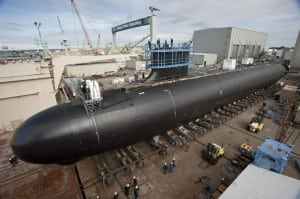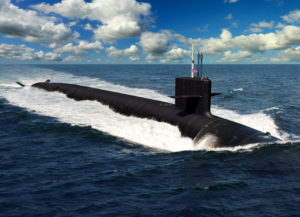Navy officials this week said they expect industry to be able to produce two Virginia-class attack submarines (SSN) per year by 2028 and did not deny that the first Columbia-class ballistic missile submarine (SSBN) may be delayed.
During the Navy’s fiscal year 2025 budget request briefing on Monday, Under Secretary of the Navy Erik Raven underscored this year’s and other recent funding requests have boosted spending for the submarine industrial base (SIB) in an effort to reach production levels the service requires.

“With an investment of $3.9 billion in FY25 and then $11.1 billion across the [five year-long Future Years Defense Program] FYDP for the submarine industrial base, and with a $3.3 billion FY24 supplemental request, the Navy expects to achieve Virginia class submarine construction performance of two per year by FY28,” Raven said in his opening statements.
“In addition to SIB, the Navy will continue initiatives in major surface shipbuilding programs as a mechanism to incentivize investment in the needed facilities of our U.S. shipbuilders,” he added.
Raven argued these kinds of investments “are necessary to meet a generational increase in demand driven by recapitalizing the most survivable leg of the nuclear triad, the Columbia, on-time delivery of Virginia submarines, maintenance of in-service submarines, and national commitments made under the AUKUS agreement.”
Despite Raven’s optimism on reaching two SSNs by FY ‘28, the Navy’s request still reduced submarine procurement in FY ‘25 to only one Virginia-class submarine rather than the previously planned two.
The Navy’s budget highlights book partially laid this at the feet of the Fiscal Responsibility Act’s budget caps that imposed “hard choices” while Raven said it redirected some of those funds into the SIB (Defense Daily, March 11).
“We removed one Virginia-class out of concern for the industrial base ability to produce yet one more, while, in a capped environment, making room for these historic investments in the submarine industrial base,” he said.
Raven reiterated the Navy still plans to procure nine of up to 10 SSNs over the FYDP.
“So in total, this FY ’25 budget really makes the necessary investments to set up for long-term success on both the Virginia and Columbia-class submarines,” he said.
Before the Navy briefing, Undersecretary of Defense Comptroller and Chief Financial Officer Michael McCord said the Virginia-class cut “was not a budget-driven decision.”
“Virginia-class is probably the primary example of something that was a management decision. The Navy proposed that — got considerable discussion inside the group, and I think we all felt that it made sense. I believe the boats that are supposed to deliver this year are averaging over 30 months late. And we have more than a dozen on order that are still in production already,” McCord said
“So the question was really what can we do to get a better result, other than keep doing the same thing and hoping for a different result than what has happened in the last couple of years,” he continued.
McCord said for current and planned SIB investments “we think is going to be money better spent than putting another submarine on order.”
“All analysis indicates we can’t get two submarines if we order them in ’25 any sooner than if we wait,” he added.
The Navy plans to sell Australia three to five used and new Virginia-class submarines in the 2030s before the country is ready to start fielding its own new SSN-AUKUS nuclear-powered attack submarines in the 2040s.

Navy officials previously said in order to both reach current submarine goals and make up for those sales, the Navy and industrial base must ultimately be able to work up to 2.33 Virginia-class submarines plus one Columbia-class per year.
The submarine builders General Dynamics’ Electric Boat [GD] and HII [HII] are currently only able to produce around 1.3 SSNs per year.
While the officials talked up investing in the SIB, they did not deny the first Columbia-class SSBN, the future USS District of Columbia (SSBN-826), may deliver up to one year late.
Capitol Forum first reported Monday the Navy is forecasting SSBN-826 will be delayed one year from FY 2027 to 2028.
Without explicitly denying the reports, Raven highlighted Secretary of the Navy Carlos Del Toro directed a 45-day review of all shipbuilding programs, “not just Virginia but look across the portfolio to assess really where we are on in terms of production of each one of those classes of ships. We’re continuing that work and we’ll have more on that in the coming weeks.”
He added that “we’re seeing stress across the industrial base. And again, I think putting this into the context of the secretary’s 45-day review will add additional…context to the challenges that we’re seeing across the shipbuilding portfolio. And we expect to have that ready fairly soon.”
Earlier on Monday, McCord first revealed the 45-day review in response to a question about slippage in the Virginia and Columbia-class submarines program.
He said “Secretary Del Toro is concerned about schedule writ large, and I think that’s being looked at right now.”
Raven confirmed the Navy is watching the production of the Columbia “extremely closely” but the 45-day review should provide “a good picture of where we are across all shipbuilding programs.”
In 2022, Rear Adm. Scott Pappano, Program Executive Officer for Strategic Submarines, said his biggest concern about SSBN production is workforce for both the prime shipyards and the vendor base (Defense Daily, Aug. 25, 2022).
The Navy started the Columbia-class program with a contracted 84-month construction time to delivery, but sought to limit that to 78 months to build in extra margin. However, the margin has been entirely taken up with very little margin left to reach the 84 month limit for the first-in-class boat.
In late 2022, Pappano said SSBN-826 only had one month of margin left (Defense Daily, Nov. 1, 2022).
During her confirmation hearing last September, Chief of Naval Operations Adm. Lisa Franchetti said the Columbia-class is no longer on that 78 month accelerated schedule “but we are meeting the contracted delivery schedule for Columbia.”